Integrated circuits having parallel conductors and their formation
Hansen , et al. Sept
U.S. patent number 10,424,506 [Application Number 15/973,784] was granted by the patent office on 2019-09-24 for integrated circuits having parallel conductors and their formation. This patent grant is currently assigned to Micron Technology, Inc.. The grantee listed for this patent is MICRON TECHNOLOGY, INC.. Invention is credited to Tyler G. Hansen, Vishal Sipani, Ming-Chuan Yang.
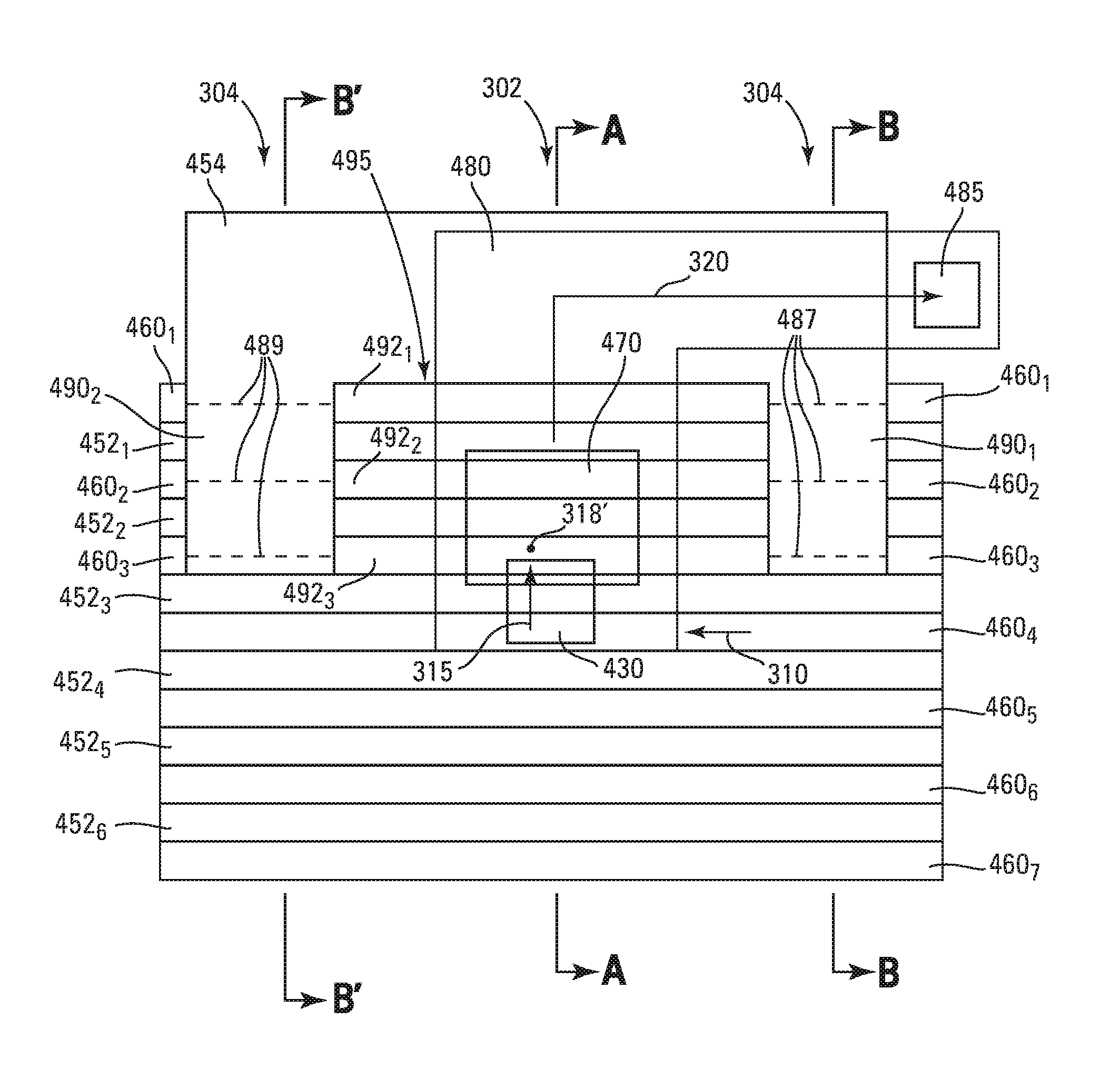


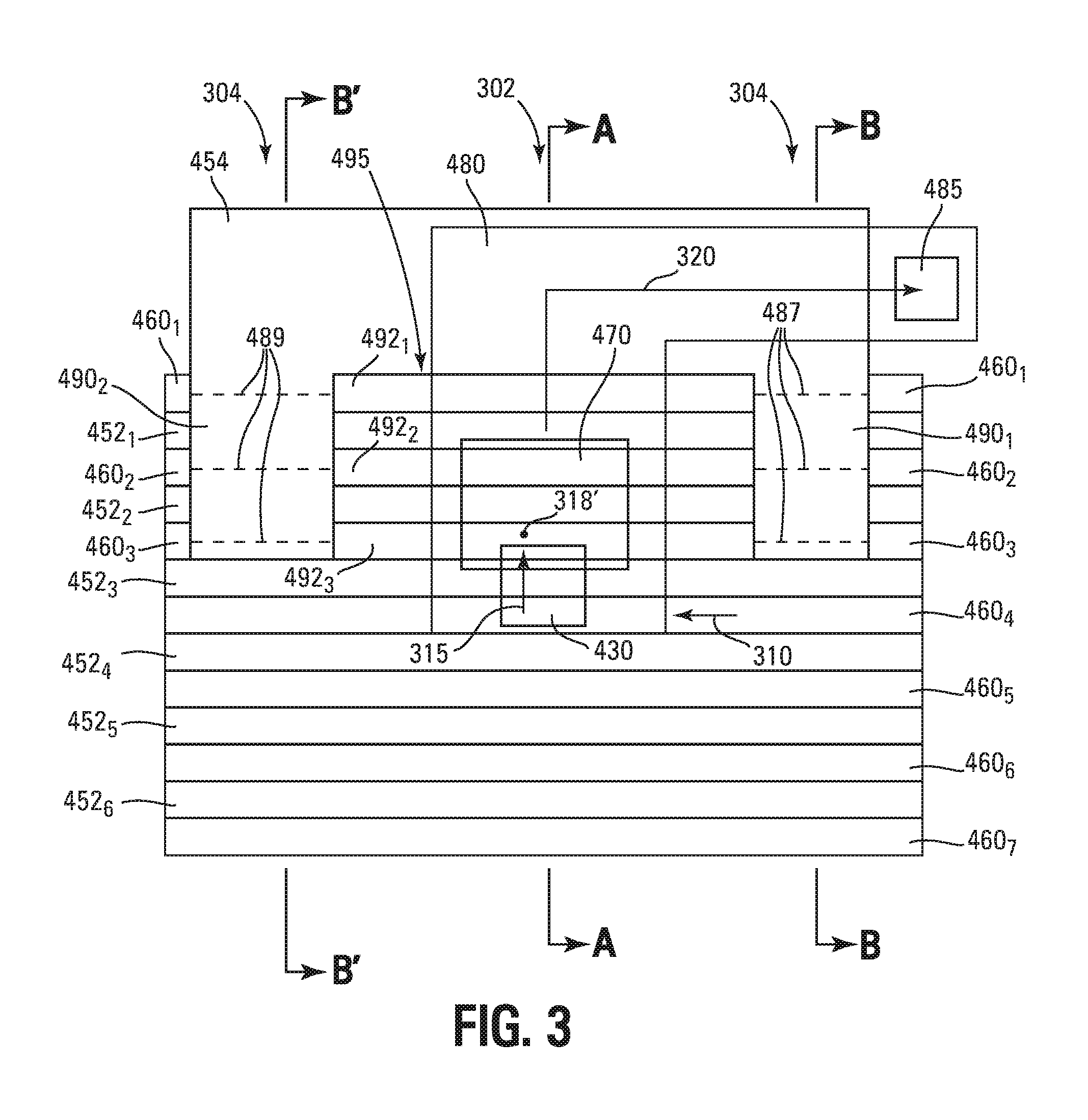


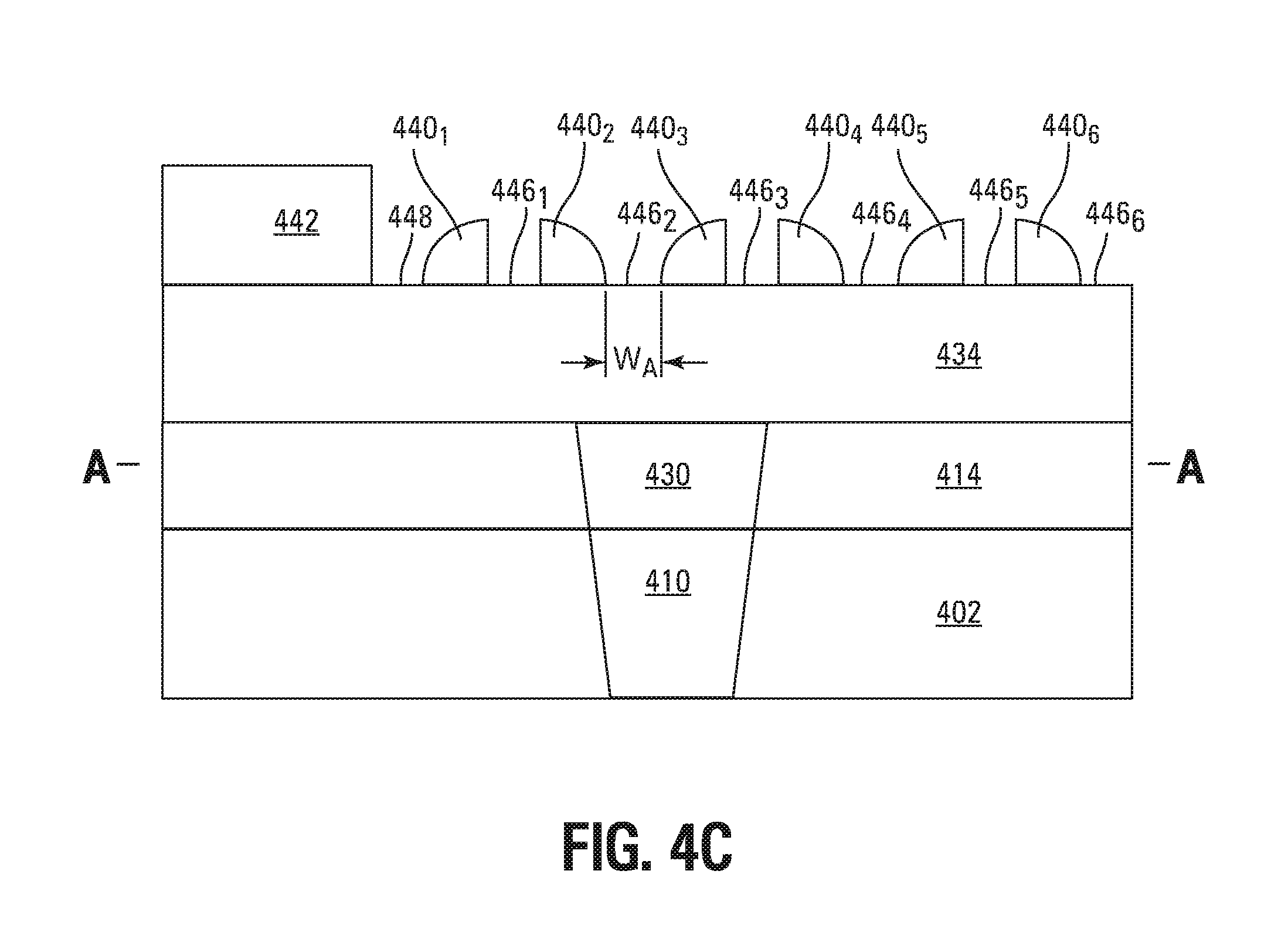

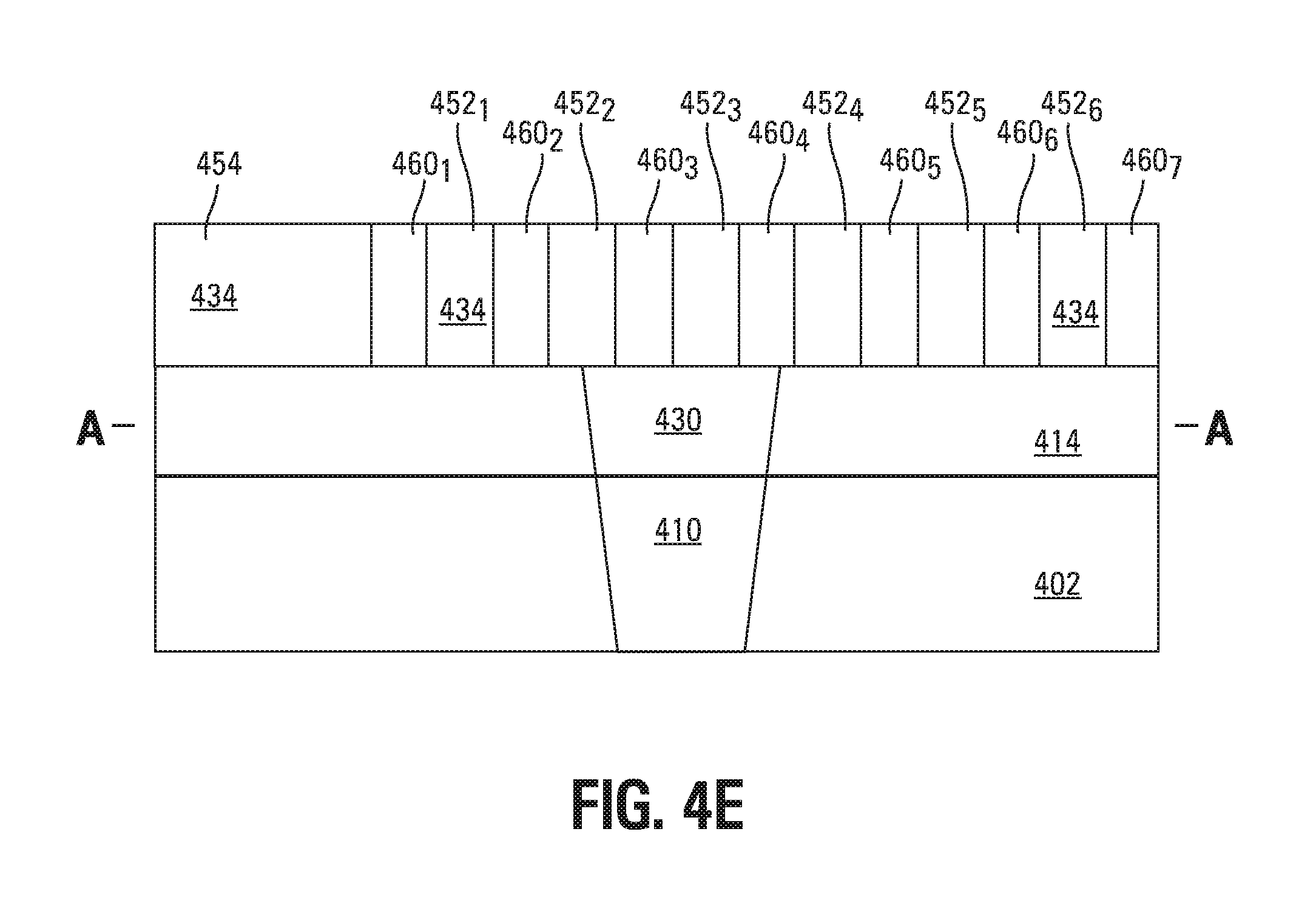
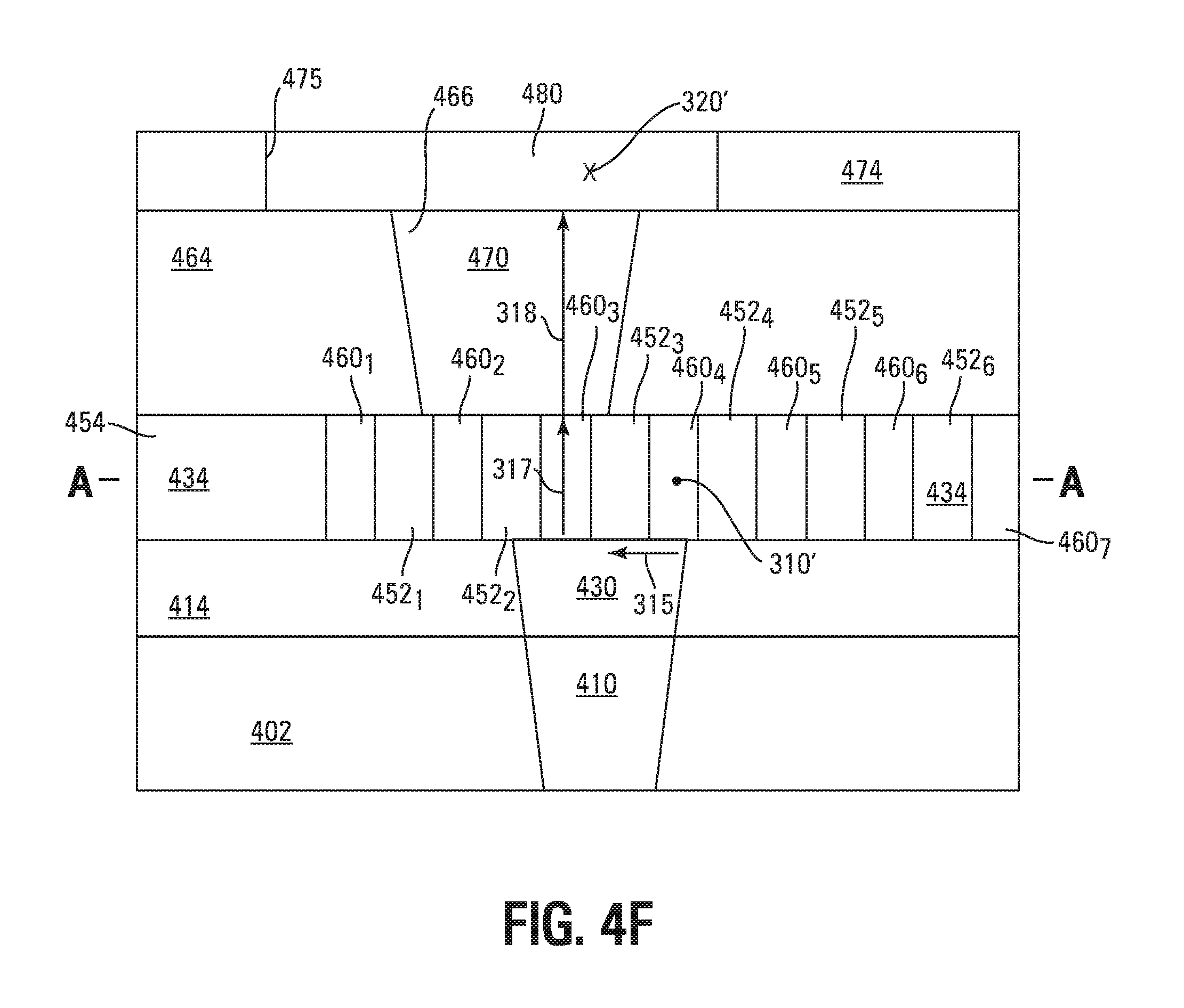

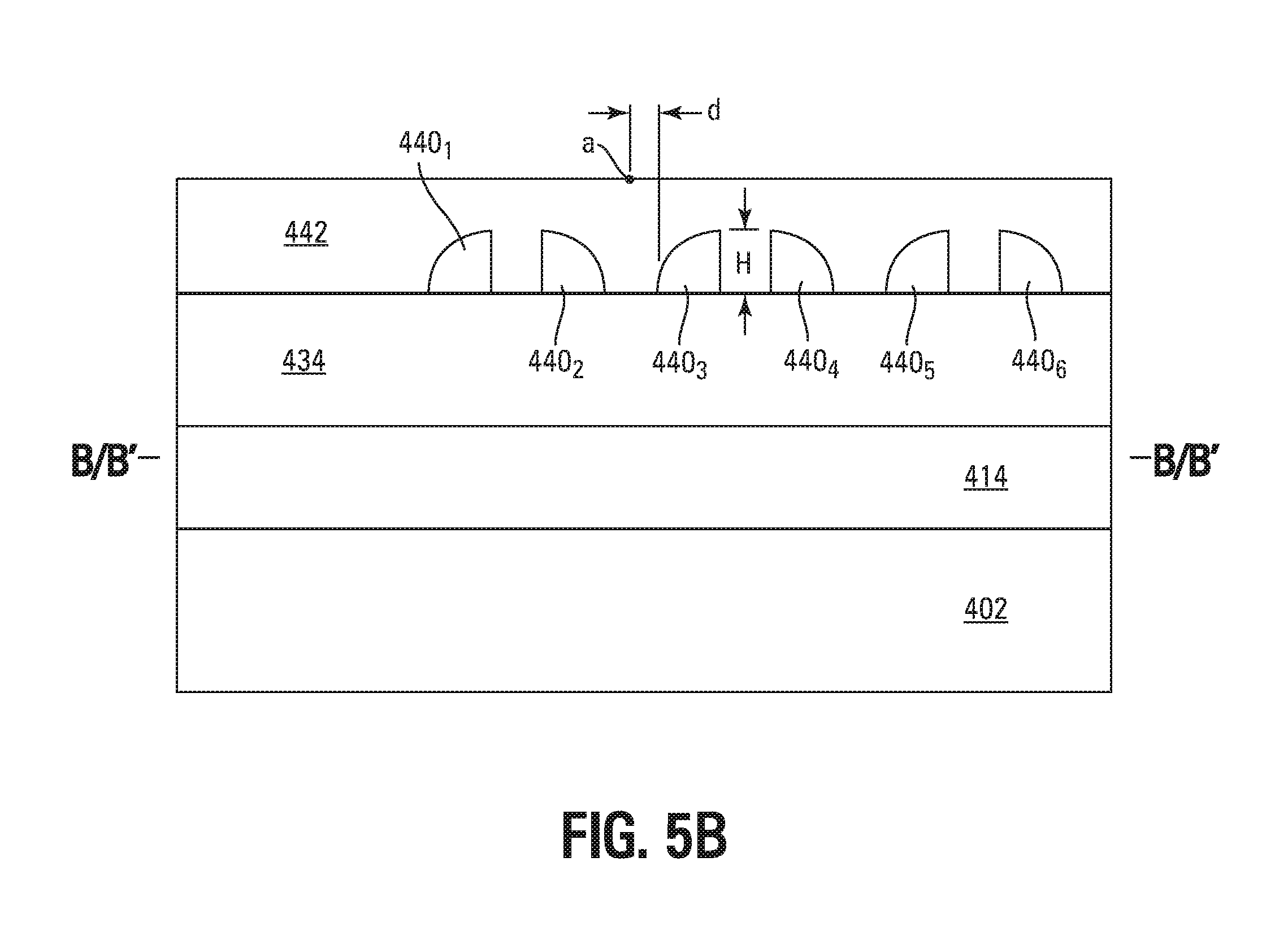
View All Diagrams
| United States Patent | 10,424,506 |
| Hansen , et al. | September 24, 2019 |
Integrated circuits having parallel conductors and their formation
Abstract
Integrated circuits, as well as methods of their formation, include a first conductive structure at a first level of the integrated circuit, a second conductive structure at a second level of the integrated circuit, a first conductor at a third level of the integrated circuit between the first level and the second level, a second conductor at the third level and parallel to the first conductor, and a third conductor at the third level and parallel to the first conductor and to the second conductor. The first conductive structure is in physical and electrical contact with the first conductor and the second conductor. The second conductive structure is in physical and electrical contact with the second conductor and the third conductor.
| Inventors: | Hansen; Tyler G. (Boise, ID), Yang; Ming-Chuan (Meridian, ID), Sipani; Vishal (Boise, ID) | ||||||||||
|---|---|---|---|---|---|---|---|---|---|---|---|
| Applicant: |
|
||||||||||
| Assignee: | Micron Technology, Inc. (Boise,
ID) |
||||||||||
| Family ID: | 49379345 | ||||||||||
| Appl. No.: | 15/973,784 | ||||||||||
| Filed: | May 8, 2018 |
Prior Publication Data
| Document Identifier | Publication Date | |
|---|---|---|
| US 20180254214 A1 | Sep 6, 2018 | |
Related U.S. Patent Documents
| Application Number | Filing Date | Patent Number | Issue Date | ||
|---|---|---|---|---|---|
| 14887359 | Oct 20, 2015 | 9972532 | |||
| 13449452 | Nov 3, 2015 | 9177910 | |||
| Current U.S. Class: | 1/1 |
| Current CPC Class: | H01L 21/76895 (20130101); H01L 23/535 (20130101); H01L 23/5226 (20130101); H01L 21/76802 (20130101); H01L 21/76838 (20130101); H01L 21/31144 (20130101); H01L 21/76877 (20130101); H01L 21/0337 (20130101); H01L 23/522 (20130101); H01L 2924/0002 (20130101); H01L 21/76816 (20130101); H01L 23/5329 (20130101); H01L 2924/0002 (20130101); H01L 2924/00 (20130101) |
| Current International Class: | H01L 21/768 (20060101); H01L 23/535 (20060101); H01L 21/311 (20060101); H01L 21/033 (20060101); H01L 23/522 (20060101); H01L 23/532 (20060101) |
References Cited [Referenced By]
U.S. Patent Documents
| 4808552 | February 1989 | Anderson |
| 5631478 | May 1997 | Okumura |
| 5760477 | June 1998 | Cronin |
| 6060383 | May 2000 | Nogami et al. |
| 6100591 | August 2000 | Ishii |
| 6174803 | January 2001 | Harvey |
| 7042092 | May 2006 | Yegnashankaran et al. |
| 7141881 | November 2006 | Takayama et al. |
| 7161226 | January 2007 | Chen et al. |
| 7767573 | August 2010 | Tang et al. |
| 7808053 | October 2010 | Haller et al. |
| 7816262 | October 2010 | Juengling |
| 7923373 | April 2011 | Sandhu |
| 2004/0188842 | September 2004 | Takewaka et al. |
| 2004/0227241 | November 2004 | Enomoto |
| 2005/0082577 | April 2005 | Usui |
| 2005/0179134 | August 2005 | Matsubara |
| 2007/0222053 | September 2007 | Wei et al. |
| 2009/0243087 | October 2009 | Nakamura et al. |
| 2011/0084397 | April 2011 | Lung |
| 2012/0043661 | February 2012 | Lindsay |
| 2014/0248773 | September 2014 | Tsai |
Attorney, Agent or Firm: Dicke, Billig & Czaja, PLLC
Parent Case Text
RELATED APPLICATIONS
This is a continuation of U.S. application Ser. No. 14/887,359, filed Oct. 20, 2015, issued as U.S. Pat. No. 9,972,532 on May 15, 2019, which is a divisional of U.S. application Ser. No. 13/449,452, filed Apr. 18, 2012, issued as U.S. Pat. No. 9,177,910 on Nov. 3, 2015, which are commonly assigned and incorporated in its entirety herein by reference.
Claims
What is claimed is:
1. A method of forming an integrated circuit, comprising: forming a first conductive structure at a first level of the integrated circuit; forming a first conductor at a second level of the integrated circuit to be in physical and electrical contact with the first conductive structure; forming a second conductor at the second level to be in physical and electrical contact with the first conductive structure, and to be parallel to the first conductor; forming a third conductor at the second level to be isolated from the first conductive structure, and to be parallel to the first conductor and to the second conductor; and forming a second conductive structure at a third level of the integrated circuit to be in physical and electrical contact with the second conductor and with the third conductor, wherein the second level is between the first level and the third level; wherein forming the first conductor, forming the second conductor and forming the third conductor comprises: forming a plurality of spacers over a dielectric formed at the second level; masking portions of the plurality of spacers; removing portions of the dielectric exposed between adjacent unmasked spacers of the plurality of spacers to define a plurality of openings in the dielectric, wherein a first opening of the plurality of openings exposes a first portion of the first conductive structure and wherein a second opening of the plurality of openings exposes a second portion of the first conductive structure; and forming a conductive material in the plurality of openings.
2. A method of forming an integrated circuit, comprising: forming a first conductive structure in a first dielectric; forming a second dielectric over the first conductive structure and the first dielectric; forming a plurality of spacers over the second dielectric, leaving a first plurality of exposed portions of the second dielectric between adjacent spacers of the plurality of spacers; forming a mask over a first portion of the plurality of spacers and over a second portion of the plurality of spacers, leaving a second plurality of exposed portions of the second dielectric between adjacent unmasked spacers of the plurality of spacers, wherein the second plurality of exposed portions of the second dielectric is a subset of the first plurality of exposed portions of the second dielectric; removing the second plurality of exposed portions of the second dielectric to define a plurality of openings in the second dielectric, exposing a first portion of the first conductive structure, a second portion of the first conductive structure, and a portion of the first dielectric; forming a conductive material in the plurality of openings in the second dielectric to define a plurality of conductors, wherein a first conductor of the plurality of conductors is formed to be in physical and electrical contact with the first portion of the first conductive structure, a second conductor of the plurality of conductors is formed to be in physical and electrical contact with the second portion of the first conductive structure, and a third conductor of the plurality of conductors is formed to be isolated from the first conductive structure; forming a third dielectric over the second dielectric and over the plurality of conductors; and forming a second conductive structure in the third dielectric to be in physical and electrical contact with the second conductor and to be in physical and electrical contact with the third conductor.
3. The method of claim 2, wherein the portion of the first dielectric is a first portion of the first dielectric, and wherein removing the second plurality of exposed portions of the second dielectric further comprises exposing a second portion of the first dielectric.
4. The method of claim 2, wherein forming the plurality of spacers over the second dielectric comprises: forming a plurality of mask segments over the second dielectric; forming a fourth dielectric over the plurality of mask segments and over the second dielectric; and anisotropically removing portions of the fourth dielectric.
5. The method of claim 2, wherein forming the third dielectric over the second dielectric and over the plurality of conductors comprises forming the third dielectric after removing the mask and removing the plurality of spacers.
6. The method of claim 2, further comprising: forming a conductive line over the second conductive structure, wherein the conductive line is in electrical contact with the second conductive structure.
Description
FIELD
The present disclosure relates generally to integrated circuits, and, in particular, the present disclosure relates to interconnect structures for integrated circuits and their formation, where the interconnect structures may have conductive overpasses and/or conductive underpasses.
BACKGROUND
Integrated circuits, such as memory devices, are continually being reduced in size. As a result, higher numbers of electronic components are present in a given area of integrated circuitry, resulting in a need for smaller pitched interconnect structures for physically and/or electrically connecting the integrated circuitry, e.g., to external support structures and external circuitry.
For example, internal lines, e.g., control signal lines, address signal lines, DQ signal lines, interconnect lines, etc., within memory devices, such as a dynamic random access memory (DRAM), flash memory, static random access memory (SRAM), ferroelectric (FE) memory, etc., are becoming smaller. In some applications, these internal lines may be connected to conductive pads or pins on a printed circuit board that forms a portion of a memory package.
Pitch is a quantity commonly used when addressing the spacing between neighboring features, such as adjacent conductive lines, in an integrated circuit. For example, pitch may be defined as the center-to-center distance between two adjacent lines. Lines are typically defined by spaces between adjacent lines, where the spaces may be filled by a material, such as a dielectric. As a result, pitch can be viewed as the sum of the width of a line and of the width of the space on one side of the line, separating that line from an adjacent line. However, due to factors such as optics and light or radiation wavelength, photolithography techniques each have a minimum pitch below which a particular photolithographic technique cannot reliably form lines. Thus, the minimum pitch of a photolithographic technique is an obstacle to continued line size reduction.
"Pitch multiplication," such as "pitch doubling," is commonly used for extending the capabilities of photolithographic techniques beyond their minimum pitch. The pitch is actually reduced by a certain factor during "pitch multiplication." For example, the pitch is halved during "pitch doubling."
Contacts are sometimes used to electrically and/or physically connect lines, such as pitch-multiplied conductive lines, to other lines (e.g., at other vertical levels) within the integrated circuit. For example, the other lines may connect integrated circuitry to external support structures and external circuitry.
The contacts can be larger than the pitch-multiplied conductive lines and the pitch, making it difficult to connect a contact to a pitch-multiplied conductive line without contacting an adjacent pitch-multiplied conductive line with the contact, thereby shorting the adjacent lines together. Therefore, a pitch-multiplied conductive line may be enlarged in the region where it is to be connected to a contact, e.g., so that the contact may be entirely enclosed within the region. However, the dielectric between adjacent pitch-multiplied conductive lines can break down where it wraps around the enlarged region, causing an electrical short between the adjacent pitch-multiplied conductive lines.
For the reasons stated above, and for other reasons stated below which will become apparent to those skilled in the art upon reading and understanding the present specification, there is a need in the art for alternatives for connecting contacts to conductive lines.
BRIEF DESCRIPTION OF THE DRAWINGS
FIG. 1 is a simplified block diagram of an electronic system, according to an embodiment.
FIG. 2 is a top-down view of a layout of conductors within a portion of an integrated circuit device, according to the prior art.
FIG. 3 is a top-down view of a layout of an interconnect structure within a portion of an integrated circuit device, according to an embodiment.
FIGS. 4A-4F show a cross-section viewed along line A-A in FIG. 3 during various stages of fabrication.
FIGS. 5A-5F show a cross-section viewed along lines B-B and B'-B' in FIG. 3 during various stages of fabrication.
FIG. 6A is a top view of FIGS. 4C and 5C, according to another embodiment.
FIG. 6B is a top view of FIGS. 4E and 5E, according to another embodiment.
FIG. 7 is a top-down view illustrating accessing conductors in an interconnect structure of an integrated circuit using conductive overpasses, according to another embodiment.
FIG. 8 is a top-down view illustrating accessing conductors in an interconnect structure of an integrated circuit using conductive underpasses, according to another embodiment.
FIG. 9 is a top-down view of a layout of an interconnect structure of an integrated circuit device, according to another embodiment.
FIGS. 10A-10B show a cross-section viewed along lines C-C and C'-C' in FIG. 9 during various stages of fabrication.
FIG. 11 shows a cross-section viewed along line D-D in FIG. 9.
DETAILED DESCRIPTION
In the following detailed description, reference is made to the accompanying drawings that form a part hereof, and in which is shown, by way of illustration, specific embodiments. In the drawings, like numerals describe substantially similar components throughout the several views. Other embodiments may be utilized and structural, logical, and electrical changes may be made without departing from the scope of the present disclosure. The following detailed description is, therefore, not to be taken in a limiting sense.
The term semiconductor, as used herein, can refer to, for example, a layer of material, a wafer, or a substrate, and includes any base semiconductor structure. "Semiconductor" is to be understood as including silicon-on-sapphire (SOS) technology, silicon-on-insulator (SOI) technology, thin film transistor (TFT) technology, doped and undoped semiconductors, epitaxial layers of a silicon supported by a base semiconductor structure, as well as other semiconductor structures well known to one skilled in the art. Furthermore, when reference is made to a semiconductor in the following description, previous process steps may have been utilized to form regions/junctions in the base semiconductor structure, and the term semiconductor can include the underlying layers containing such regions/junctions.
FIG. 1 is a simplified block diagram of an electronic system, such as a memory system 100, that may include an integrated circuit device, such as an integrated circuit memory device 102. Memory device 102 may be a flash memory device (e.g., a NAND memory device), a DRAM, an SDRAM, etc., that includes an array of memory cells 104, an address decoder 106, row access circuitry 108, column access circuitry 110, control circuitry 112, input/output (I/O) circuitry 114, and an address buffer 116. Memory system 100 includes an external microprocessor 120, such as a memory controller or other external host device, coupled to memory device 102 for memory accessing as part of the electronic system.
The memory device 102 receives control signals (which represent commands) from the processor 120 over a control link 122. Memory device 102 receives data signals (which represent data) over a data (DQ) link 124. The memory cells are used to store the data. Address signals (which represent addresses) are received via an address link 126 that are decoded at address decoder 106 to access the memory array 104. Address buffer circuit 116 latches the address signals. The memory cells are accessed in response to the control signals and the address signals.
Conductors, e.g., conductive lines, such as pitch-multiplied conductors, of an interconnect structure of the integrated circuit device, e.g., memory device 102, may be laid out according to various embodiments disclosed herein. For example, the conductors may be accessed using conductive underpasses and/or conductive overpasses, e.g., so that the conductors remain substantially straight (e.g., straight). A conductive overpass or a conductive underpass might be coupled to adjacent conductors, where one of the conductors might be electrically coupled to circuitry of the integrated circuit device and where the other might be floating but for its coupling to the conductive overpass or the conductive underpass. The conductive overpass might pass over a dielectric between conductors, whereas the conductive underpass might pass under the dielectric.
It will be appreciated by those skilled in the art that additional circuitry and signals can be provided, and that the electronic system of FIG. 1 has been simplified. It should be recognized that the functionality of the various block components described with reference to FIG. 1 may not necessarily be segregated to distinct components or component portions of an integrated circuit device. For example, a single component or component portion of an integrated circuit device could be adapted to perform the functionality of more than one block component of FIG. 1. Alternatively, one or more components or component portions of an integrated circuit device could be combined to perform the functionality of a single block component of FIG. 1.
FIG. 2 is a top-down view illustrating a layout of conductors, e.g., conductive lines, within a portion of an integrated circuit device, according to the prior art. The integrated circuit may include a plurality of conductors, such as conductive lines 210 (e.g., lines 210.sub.1 to 210.sub.8), e.g., that may be formed using pitch multiplication. A dielectric 220 is formed on either side of each line 210 and thus defines that line 210. For example, a dielectric 220 forms a loop around each of lines 210.sub.1, 210.sub.3, 210.sub.4, and 210.sub.6. The dielectric 220 electrically isolates a particular line 210 from adjacent lines 210.
Lines 210.sub.1, 210.sub.3, 210.sub.4, and 210.sub.6 are respectively connected to contacts 230.sub.1, 230.sub.2, 230.sub.3, and 230.sub.4 that may respectively connect lines 210.sub.1, 210.sub.3, 210.sub.4, and 210.sub.6 to lines (not shown), e.g., that may be formed on other vertical levels of the integrated circuit. Portions 250 of lines 210.sub.1, 210.sub.3, 210.sub.4, and 210.sub.6 to which contacts 230.sub.1, 230.sub.2, 230.sub.2, and 230.sub.4 are respectively connected are enlarged to have an area that is larger than contacts 230.sub.1, 230.sub.2, 230.sub.2, and 230.sub.4. This is because a width of a contact 230 may be greater than the combined width of the respective line 210 and the dielectric 220 on one or both sides of the respective line 210. Therefore, the contact 250 could short the respective line 210 to at least one of the lines adjacent to the respective line 210 if the contact is not connected to an enlarged portion 250.
Prior to forming a line 210 having an enlarged portion 250 (e.g., sometimes referred to as a "flag"), a loop of dielectric 220 may be formed around the region in which the enlarged portion 250 will be formed. For example, such a loop may include a number of corners (e.g., substantially 90-degree corners), as shown in FIG. 2. However, openings (e.g., breaks) may form in dielectric 220 when the dielectric 220 spans a relatively large distance between successive corners, as indicated by arrows 260 in FIG. 2. The conductive material used to form lines 210 may seep through these openings during the formation of lines 210 and may produce a short between adjacent lines. For example, the enlarged portion 250 of line 210.sub.3 may shorted to line 210.sub.2 and/or line 2107 at or near the locations indicated by arrows 260.
FIG. 3 is a top-down view of a circuit layout, e.g., in an interconnect structure of an integrated circuit device, such as memory device 102 of FIG. 1, including substantially straight (e.g., straight) conductors, e.g., conductive lines. For example, FIG. 3 illustrates how to access to a conductor, such as a conductive line 460.sub.4, using a conductive underpass (e.g., using a conductive plug 430 as an underpass) and a conductive overpass (e.g., using conductive contact 470 as an overpass), so that the conductors remain substantially straight (e.g., straight).
Conductive lines 460.sub.4 to 460.sub.7 may be electrically coupled to circuitry of the integrated circuit device. The conductive lines 460.sub.1 to 460.sub.3 to the right of a portion 490.sub.1 of a dielectric segment 454 and to the left of a portion 490.sub.2 of dielectric segment 454 may be coupled to different circuitry of the integrated circuit device. However, the conductors (e.g., conductive line segments 492.sub.1, 492.sub.2, and 492.sub.3) between portions 490.sub.1 and 490.sub.2 may be floating, e.g., electrically isolated. For example, conductive line segment 492.sub.2 may be floating but for its coupling to contact 470, and conductive line segment 492.sub.3 may be floating but for its coupling to plug 430 and contact 470.
FIG. 3 is intended to show where the various cross-sections discussed below are taken and how the various cross-sections relate to the overall layout of the portion of the integrated circuit device shown in FIG. 3. FIGS. 4A-4F show a cross-section viewed along line A-A in FIG. 3 during various stages of fabrication, and FIGS. 5A-5F show a cross-section viewed along each of lines B-B and B'-B' in FIG. 3 during various stages of fabrication. For example, FIGS. 4A-4F correspond to a region 302 of the integrated circuit device of FIG. 3, and FIGS. 5A-5F to each of regions 304 of the integrated circuit device of FIG. 3.
For some embodiments, the stages of fabrication shown in FIGS. 4A-4F are respectively substantially concurrent with (e.g., concurrent with) the stages of fabrication shown in FIGS. 5A-5F. The use of the term "substantially" herein accounts for routine process variations. For example, industrial processes, and thus structures produced thereby, are not exact, and minor variations may occur.
In FIGS. 4A and 5A, a dielectric 402 may be formed over a semiconductor 400 that may include active regions. The semiconductor may be comprised of silicon, e.g., monocrystalline silicon, that may be conductively doped to have p-type conductivity or n-type conductivity. Alternatively, for other embodiments, dielectric 402 may be formed over another dielectric that is similar to (e.g., the same as) dielectric 402 or over wiring (e.g., a conductive line). Dielectric 402 may be generally formed of one or more dielectric materials. For example, dielectric 402 may be formed from an oxide, e.g., silicon oxide.
An opening 404 may be formed through dielectric 402, as shown in FIG. 4A, stopping on or in the semiconductor, dielectric, or wiring under dielectric 402. Opening 404 may be formed by patterning dielectric 402 and removing exposed portions of dielectric 402. For example, for some embodiments, a mask (not shown), e.g., imaging resist, such as photoresist, may be formed over dielectric 402 and patterned to define a region of dielectric 402 for removal. The region defined for removal is subsequently removed, e.g., by etching, to form opening 404. For some embodiments, opening 404 may expose an active area in the semiconductor.
A conductive plug 410 may be formed in opening 404 from a conductor, as shown in FIG. 4A, e.g., so that conductive plug 410 may be coupled to an active region or the wiring under dielectric 402, e.g., conductive plug 410 may be in direct physical contact with the active region or the wiring. For example, the conductor may be deposited in opening 404 and possibly over dielectric 402, such as by blanket deposition. The conductor 408 may then be removed from dielectric 402, e.g., by chemical mechanical planarization (CMP), thereby forming conductive plug 410.
The conductor from which conductive plug 410 is formed may be generally formed of one or more conductive materials. For example, the conductor from which conductive plug 410 is formed may comprise, consist of, or consist essentially of conductively doped polysilicon and/or may comprise, consist of, or consist essentially of metal, such as a refractory metal, or a metal-containing material, such as a refractory metal silicide or a metal nitride, e.g., a refractory metal nitride, as well as any other conductive material.
A dielectric 414 may then be formed over dielectric 402 and conductive plug 410, as shown in FIGS. 4A and 5A. Dielectric 414 may be generally formed of one or more dielectric materials. For example, dielectric 414 may be formed from an oxide, e.g., silicon oxide.
An opening 420 may then be formed through dielectric 414, stopping at or in conductive plug 410, thereby exposing conductive plug 410, as shown in FIG. 4A. That is, opening 420 may be aligned (e.g., vertically aligned) with conductive plug 410.
Opening 420 may be formed by patterning dielectric 414 and removing exposed portions of dielectric 414. For example, for some embodiments, a mask (not shown), e.g., imaging resist, such as photoresist, may be formed over dielectric 414 and patterned to define a region of dielectric 414 for removal. The region defined for removal is subsequently removed, e.g., by etching, to form opening 420.
A conductive underpass (e.g. a conductive plug 430) may be formed in opening 420 from a conductor, as shown in FIG. 4A, so that the conductive underpass may be coupled to conductive plug 410, e.g., the conductive underpass may be in direct physical contact with conductive plug 410. For example, the conductor may be deposited in opening 420 and possibly over dielectric 414, such as by blanket deposition. The conductor may then be removed from dielectric 414, e.g., by CMP, thereby forming conductive plug 430.
The conductor from which conductive plug 430 is formed may be generally formed of one or more conductive materials. For example, the conductor from which conductive plug 430 is formed may comprise, consist of, or consist essentially of conductively doped polysilicon and/or may comprise, consist of, or consist essentially of metal, such as a refractory metal, or a metal-containing material, such as a refractory metal silicide or a metal nitride, e.g., a refractory metal nitride, as well as any other conductive material. Where no electrical connection is desired below conductive plug 430, conductive plug 410 may be eliminated such that conductive plug 430 is formed on dielectric 402. Alternatively, conductive plug 430 could provide the connection to an underlying active area or wiring without the formation of conductive plug 410.
A dielectric 434 may then be formed over dielectric 414 and conductive plug 430, as shown in FIGS. 4A and 5A. Dielectric 434 may be generally formed of one or more dielectric materials. For example, dielectric 434 may be formed from an oxide, e.g., silicon oxide.
Mask segments 436 may be formed on dielectric 434, as shown in FIGS. 4A and 5A. For example, mask segments 436 may be formed from a mask layer, such as a photoresist layer, that is formed over dielectric 434 and that is patterned to form mask segments 436.
Spacers 440 (e.g., spacers 440.sub.1 to 440.sub.6) may then be formed on sidewalls of mask segments 436. For example, spacers 440 may be formed from a dielectric, e.g., silicon nitride, silicon oxide, etc., that is formed over mask segments 436 and dielectric 434, e.g., using a blanket deposition. Portions of the dielectric may then be anisotropically removed so that remaining portions of the dielectric self-align with and form spacers 440 on sidewalls of mask segments 436, as shown in FIGS. 4A and 5A. For one embodiment, this may be accomplished using an anisotropic etching process that selectively removes horizontal portions of the dielectric, thus leaving spacers 440 on the sidewalls of mask segments 436.
Mask segments 436 are removed substantially concurrently (e.g., concurrently) in FIGS. 4B and 5B, e.g., using an etch selective to mask segments 436, stopping, for example, at an upper surface of dielectric 434 and leaving spacers 440.sub.1 to 440.sub.6. Note that spacers 440.sub.1 to 440.sub.6 in FIG. 4B are respectively contiguous with spacers 440.sub.1 to 440.sub.6 in FIG. 5B. In other words, spacers 440.sub.1 to 440.sub.6 may be continuous structures that may extend perpendicularly into the face plane of FIG. 4B to the face plane of FIG. 5B.
A mask (e.g., photoresist) 442, is formed over dielectric 434 and spacers 440, as shown in FIGS. 4B and 5B. Mask 442 is then patterned so that mask 442 is removed, in FIG. 4C (e.g., in region 302 of FIG. 3), from all of spacers 440.sub.1 to 440.sub.6, and from the space 446.sub.1 between successively adjacent spacers 440.sub.1 and 440.sub.2, the space 446.sub.2 between successively adjacent spacers 440.sub.2 and 440.sub.3, the space 446.sub.3 between successively adjacent spacers 440.sub.3 and 440.sub.4, the space 446.sub.4 between successively adjacent spacers 440.sub.4 and 440.sub.5, the space 446.sub.5 between successively adjacent spacers 440.sub.5 and 440.sub.6, and the space 446.sub.6 to the right of spacer 440.sub.6. Mask 442 is removed so that there is a space 448 between spacer 440.sub.1 and mask 442, as shown in FIG. 4C.
Substantially concurrently with (e.g., concurrently with) the removal of mask 442 in FIG. 4C, in FIG. 5C (e.g., in regions 304 of FIG. 3), mask 442 is removed from spacers 440.sub.3 to 440.sub.6 and from the space 446.sub.3 between successively adjacent spacers 440.sub.3 and 440.sub.4, the space 446.sub.4 between successively adjacent spacers 440.sub.4 and 440.sub.5, the space 446.sub.5 between successively adjacent spacers 440.sub.5 and 440.sub.6 and the space 446.sub.6 to the right of spacer 440.sub.6. However, mask 442 remains over and covers the portions of successively adjacent spacers 440.sub.1 and 440.sub.2 in FIG. 5C, the portion of the space 446.sub.1 between the covered portions of successively adjacent spacers 440.sub.1 and 440.sub.2 in FIG. 5C, and the portion of the space 446.sub.2 between the covered portion of spacer 440.sub.2 and the successively adjacent uncovered spacer 440.sub.3 in FIG. 5C.
For example, in embodiments where mask 442 is positive photoresist, the portions of mask 442 to be removed may be exposed to electromagnetic radiation and subsequently removed upon application of a developer solution, while the portions of mask 442 that are not to be removed are not exposed to the electromagnetic radiation, and are thus not removed by the developer solution. Conversely, in embodiments where mask 442 is negative photoresist, the portions of mask 442 that are not to be removed may be exposed to electromagnetic radiation, while the portions of mask 442 that are to be removed are not exposed to the electromagnetic radiation and are subsequently removed upon application of a developer solution.
For embodiments where mask 442 is positive photoresist, the region to the right of location a, and, for example, including the location a, in FIG. 5B might be exposed to electromagnetic radiation, whereas the region to the left of location a might not be exposed to the electromagnetic radiation, where location a might be at a lateral distance d (e.g., that may have a value of up to about 16 nanometers) from a sidewall of spacer 440.sub.3 and might be between successively adjacent spacers 440.sub.2 and 440.sub.3. For embodiments where mask 442 is negative photoresist, the region to the left of location a, and, for example, including the location a, in FIG. 5B might be exposed to electromagnetic radiation, whereas the region to the right of location a might not be exposed to the electromagnetic radiation.
Subsequently, a developer solution may be applied to mask 442. However, for certain aspect ratios (e.g., H/d, where H is the height of spacer 440.sub.3), the developer solution might not penetrate all the way to the upper surface of dielectric 434, as shown in FIG. 5C, e.g., in the region between the upper surface of spacer 440.sub.3 and the upper surface of dielectric 434 within space 446.sub.2. As such, a portion 445 of mask 442 may remain between location a and the sidewall of spacer 440.sub.3 in the region between the upper surface of spacer 440.sub.3 and the upper surface of dielectric 434. For example, this phenomenon may be referred to as "scumming."
For example, in FIG. 5C mask 442 may be said to be "scummed" to spacer 440.sub.3. The "scumming" technique used herein may be referred to as a self-alignment technique, in that mask 442 self-aligns to the sidewall of spacer 440.sub.3. In other words, mask 442 may be contiguous with (e.g., may abut) the sidewall of spacer 440.sub.3.
Note that portion 445 is in condition for removal by the developer solution, but is not removed by the developer solution, in that the aspect ratio is such that developer solution cannot sufficiently reach portion 445 to effect full removal. That is, portion 445 exposed to electromagnetic radiation when mask 442 is positive photoresist and is not exposed to radiation when mask 442 is negative photoresist.
"Scumming" is usually undesirable, in that it is usually desired to remove all of the unhardened mask material. However, for some embodiments herein, "scumming" is used advantageously to leave portion 445 of mask 442 between location a and the sidewall of spacer 440.sub.3 so that portion 445 protects the portion of dielectric 434 thereunder from removal in a subsequent removal process. That is, portion 445 may fill in the remainder of space 446.sub.2 between spacers 440.sub.2 and 440.sub.3 and may contiguous with, e.g., may abut, spacer 440.sub.3.
For some embodiments, the distance between successively adjacent spacers 440.sub.1 and 440.sub.2, between successively adjacent spacers 440.sub.2 and 440.sub.3, and between successively adjacent spacers 440.sub.3 and 440.sub.4 (e.g., the width W.sub.B of spaces 446.sub.1, 446.sub.2, and 446.sub.3) in regions 304 of the integrated circuit device corresponding to FIG. 5C may be greater than the distance between successively adjacent spacers 440.sub.1 and 440.sub.2, between successively adjacent spacers 440.sub.2 and 440.sub.3, and between successively adjacent spacers 440.sub.3 and 440.sub.4 (e.g., the width W.sub.A of spaces 446.sub.1, 446.sub.2, and 446.sub.3) in the region 302 of the integrated circuit device corresponding to FIG. 4C. This is also shown in FIG. 6A a top view of FIGS. 4C and 5C, according to some embodiments, where FIG. 4C is a cross-section viewed along line 4C-4C in FIG. 6A, and FIG. 5C is a cross-section viewed along line 5C-5C in FIG. 6A. In other words, there may be a bulge in the portion of spaces 446.sub.1 and 446.sub.2 left under a portion of mask 442 and a bulge in the portion of space 446.sub.3 that is successively adjacent to the spacer 440.sub.3 that is contiguous with (e.g., self-aligned to) that portion of mask 442. Note that conductive lines may be ultimately formed in the portions of dielectric 434 corresponding to space 448 and spaces 446.sub.1 to 446.sub.6, and the conductive lines may have bulges where spaces 446.sub.1, 446.sub.2, and 446.sub.3 are bulged.
The greater distance W.sub.B between successively adjacent spacers 440 in region 304 (FIG. 6A) can facilitate the "scumming" process by reducing the likelihood of a portion of mask 442 remaining in the space 446.sub.3 between successively adjacent spacers 440.sub.3 and 440.sub.4. That is, the greater distance W.sub.B between successively adjacent spacers 440 in region 304 can reduce the likelihood of mask 442 accidentally "scumming" to spacer 440.sub.4. Note, however, that the distance between successively adjacent spacers 440.sub.4 and 440.sub.5 and between successively adjacent spacers 440.sub.5 and 440.sub.6 (e.g., the width W.sub.A of spaces 446.sub.4, 446.sub.5, and 446.sub.6) in regions 302 and 304 may be substantially the same, as shown in FIG. 6A.
Spacers 440 and mask 442 form a pattern for respectively exposing portions of dielectric 434 for removal. The exposed portions of dielectric 434, corresponding to spaces 446.sub.1 to 446.sub.6 and space 448 in FIG. 4C, are removed in FIG. 4D, stopping at or in dielectric 414 and conductive plug 430. This forms opening 450.sub.1 in dielectric 434, corresponding to the space 448, and openings 450.sub.2 to 450.sub.7, respectively corresponding to the spaces 446.sub.1 to 446.sub.6, as shown in FIG. 4D. Note that openings 450.sub.3 and 450.sub.4 expose respective portions of conductive plug 430.
The exposed portions of dielectric 434, corresponding to spaces 446.sub.3 to 446.sub.6 in FIG. 5C, are removed in FIG. 5D, stopping at or in dielectric 414. This forms openings 450.sub.4 to 450.sub.7, respectively corresponding to the spaces 446.sub.3 to 446.sub.6, as shown in FIG. 5D. The removal of exposed portions of dielectric 434 in FIGS. 4D and 5D may occur substantially concurrently (e.g., concurrently) for some embodiments. For some embodiments, an anisotropic dry etch, e.g., a reactive ion etch, accomplishes the removal of the exposed portions of dielectric 434.
The portions of dielectric 434 remaining under and corresponding to respective spacers 440 and the portion of dielectric 434 remaining under and corresponding to mask 442 may be referred to segments of dielectric 434. For example, the segments of dielectric 434 remaining under and corresponding to spacers 440.sub.1 to 440.sub.6 may be respectively referred to as dielectric segments 452.sub.1 to 452.sub.6, and the segment of dielectric 434 remaining under and corresponding to mask 442 may be referred to as dielectric segment 454, as shown in FIGS. 4D and 5D. Note that dielectric segment 454 may be contiguous with (e.g., may abut) dielectric segment 452.sub.3 in FIG. 5D.
For some embodiments, after forming the openings 450.sub.1 to 450.sub.7, mask 452 may be removed from dielectric segment 454, e.g., by ashing, and spacers 440 may be removed from dielectric segments 452, e.g., by CMP. Conductive lines 460.sub.1 to 460.sub.7 may then be respectively formed in openings 450.sub.1 to 450.sub.7, as shown in FIGS. 4E and 5E.
For example, conductive lines 460.sub.1 to 460.sub.7 may be formed from a conductor that may be deposited in each of openings 450.sub.1 to 450.sub.7 and possibly over dielectric 434, such as by blanket deposition. The conductor may then be removed from dielectric 434, e.g., CMP.
At least portions of conductive lines 460.sub.3 and 460.sub.4 may be coupled to, e.g., by direct physical contact with, conductive plug 430, as shown in FIG. 4E. For example, the lower (e.g., bottom) surfaces of conductive lines 460.sub.3 and 460.sub.4 may be coupled to (e.g., in direct contact with) conductive plug 430. The technique for forming conductive lines 460 using spacers 440 may be referred to pitch multiplication (e.g., pitch doubling), and lines 460 may be referred to as pitch-multiplied (e.g., pitch-doubled) lines.
Dielectric segments 452 may be between successively adjacent conductive lines 460, e.g., dielectric segment 452.sub.1 between successively adjacent conductive lines 460.sub.1 and 460.sub.2, dielectric segment 452.sub.2 between successively adjacent conductive lines 460.sub.2 and 460.sub.3, dielectric segment 452.sub.3 between successively adjacent conductive lines 460.sub.3 and 460.sub.4, dielectric segment 452.sub.4 between successively adjacent conductive lines 460.sub.4 and 460.sub.5, dielectric segment 452.sub.5 between successively adjacent conductive lines 460.sub.5 and 460.sub.6, and dielectric segment 452.sub.6 between successively adjacent conductive lines 460.sub.6 and 460.sub.7, as shown in FIGS. 4F, 5F, and 3.
The conductor from which conductive lines 460 may be formed may be generally formed of one or more conductive materials. For example, the conductor may comprise, consist of, or consist essentially of a metal or metal-containing layer and may be aluminum, copper, a refractory metal, or a refractory metal silicide layer. In some embodiments, the conductor may contain multiple metal-containing layers, e.g., a titanium nitride (TiN) barrier layer, a titanium (Ti) adhesion layer formed over the barrier layer, and a tungsten (W) layer formed over the adhesion layer.
FIG. 6B is a top view of FIGS. 4E and 5E, corresponding to the embodiment shown in FIG. 6A, where FIG. 4E is a cross-section viewed along line 4E-4E in FIG. 6B, and FIG. 5E is a cross-section viewed along line 5E-5E in FIG. 6B. Note that the portions of lines 460.sub.2 and 460.sub.3 intersected (e.g., broken) by dielectric segment 454 may have bulges. That is, the portions of lines 460.sub.2 and 460.sub.3 in region 304 intersected by dielectric segment 454 may have a greater width W.sub.B' (e.g., distance between successive dielectric segments 452) in region 304 than the width W.sub.A' (e.g., distance between successive dielectric segments 452) of the portions of lines 460.sub.2 and 460.sub.3 in region 302, e.g., where contact 470 may be formed (FIG. 3). In addition, the portion of line 460.sub.4 in region 304, corresponding to where a portion of dielectric segment 452.sub.3 (e.g., that bounds that portion of line 460.sub.4) is contiguous with dielectric segment 454, is also bulged, e.g., may have a greater width W.sub.B' than the width W.sub.A' of the portions of line 460.sub.4 where contact 470 might be formed (FIG. 3). As indicated above in conjunction with FIG. 6A, the bulges are the result of the extra separation distance between successively adjacent spacers in order to facilitate the "scumming" process.
A dielectric 464 may then be formed over conductive lines 460.sub.1 to 460.sub.7 and dielectric 434, e.g., dielectric segments 452 and 454, in FIGS. 4F and 5F, e.g., substantially concurrently (e.g., concurrently). An opening 466 may then be formed in dielectric 464 in FIG. 4F, stopping at or in conductive lines 460.sub.2 and 460.sub.3 and at least the dielectric segment 452.sub.2 between conductive lines 460.sub.2 and 460.sub.3. Dielectric 464 may be generally formed of one or more dielectric materials. For example, dielectric 464 may be formed from an oxide, e.g., silicon oxide.
A conductive overpass (e.g., a conductive contact 470) may be formed in opening 466 in FIG. 4F from a conductor so that the conductive overpass may be coupled to conductive lines 460.sub.2 and 460.sub.3, e.g., at their upper surfaces, and at least dielectric segment 452.sub.2, e.g., so that the conductive overpass may be in direct physical contact with the upper (e.g., top) surfaces of conductive lines 460.sub.2 and 460.sub.3 and at least dielectric segment 452.sub.2. For example, the conductor may be deposited in opening 466 and possibly over dielectric 464, such as by blanket deposition. The conductor may then be removed from dielectric 464, e.g., by CMP, thereby forming conductive contact 470.
The conductor from which contact 470 may be formed may be generally formed of one or more conductive materials. For example, the conductor from which contact 470 may be formed may comprise, consist of, or consist essentially of a metal or metal-containing layer and may be aluminum, copper, a refractory metal, or a refractory metal silicide layer. In some embodiments, the conductor from which contact 470 may be formed may contain multiple metal-containing layers, e.g., a titanium nitride (TiN) barrier layer, a titanium (Ti) adhesion layer formed over the barrier layer, and a tungsten (W) layer formed over the adhesion layer. For other embodiments, the conductor from which contact 470 may be formed may comprise, consist of, or consist essentially of conductively doped polysilicon.
A dielectric 474 may then be formed over dielectric 464 and contact 470 in FIG. 4F and over dielectric 464 in FIG. 5F, e.g., substantially concurrently (e.g., concurrently). An opening 475 may then be formed in dielectric 474 in FIGS. 4F and 5F. Opening 475 may stop at or in dielectric 464 and contact 470 in FIG. 4F and at or in dielectric 464 in FIG. 5F. Dielectric 474 may be generally formed of one or more dielectric materials. For example, dielectric 474 may be formed from an oxide, e.g., silicon oxide.
A conductive line 480 may be formed in opening 475 in FIGS. 4F and 5F from a conductor, e.g., substantially concurrently (e.g., concurrently), so that conductive line 480 may be coupled to contact 470, e.g., so that conductive line 480 may be in direct physical contact with contact 470. For example, the conductor may be deposited in opening 475 and possibly over dielectric 474, such as by blanket deposition. The conductor may then be removed from dielectric 474, e.g., by CMP, thereby forming conductive line 480.
The conductor from which conductive line 480 may be formed may be generally formed of one or more conductive materials. For example, the conductor from which conductive line 480 may be formed may comprise, consist of, or consist essentially of a metal or metal-containing layer and may be aluminum, copper, a refractory metal, or a refractory metal silicide layer.
FIG. 3 shows that conductive line 460.sub.4 is coupled to line 480, and thus a conductive pad 485, by conductive plug 430 and contact 470. Portions 490.sub.1 and 490.sub.2 of dielectric segment 454 may respectively form discontinuities (e.g., breaks) 487 and 489 in conductive lines 460.sub.1, 460.sub.2, and 460.sub.3, as shown in FIG. 3. Portions 490.sub.1 and 490.sub.2 may be contiguous with a side of dielectric segment 452.sub.3, as shown in FIG. 3 and in FIG. 5F. Note that dielectric segment 454 corresponds to mask 442 in FIG. 5D and that the formation of discontinuities 487 and 489 is facilitated by the self-alignment (e.g., "scumming") of mask 442 to spacer 440.sub.3, as described above in conjunction with FIGS. 5B-5D.
Discontinuities 487 and 489 cause segments 492.sub.1, 492.sub.2, and 492.sub.3, respectively of conductive lines 460.sub.1, 460.sub.2, and 460.sub.3, between discontinuities 487 and 489 to float. For example, segments 492.sub.2 and 492.sub.3 would be floating, but for their coupling to contact 470 and plug 430. In other words, portions 490.sub.1 and 490.sub.2 electrically isolate segment 492.sub.1 and electrically isolate segments 492.sub.2, and 492.sub.3 but for their coupling to contact 470 and plug 430. Line segments 492 are located in the region (e.g., that may be called isolated region 495) between portions 490.sub.1 and 490.sub.2 of dielectric segment 454.
Note that portions of conductive lines 460.sub.1, 460.sub.2, and 460.sub.3 that are electrically and physically isolated from segments 492.sub.1, 492.sub.2, and 492.sub.3 by portion 490.sub.1, e.g., those portions of conductive lines 460.sub.1, 460.sub.2, and 460.sub.3 to the right of portion 490.sub.1 in FIG. 3, may be coupled to circuitry and that portions of conductive lines 460.sub.1, 460.sub.2, and 460.sub.3 that are electrically and physically isolated from segments 492.sub.1, 492.sub.2, and 492.sub.3 by portion 490.sub.2, e.g., those portions of conductive lines 460.sub.1, 460.sub.2, and 460.sub.3 to the left of portion 490.sub.2 in FIG. 3, may be coupled to different circuitry.
In an example, arrow 310 in FIG. 3 and dot 310' in FIG. 4F may represent the current flow in line 460.sub.4, where dot 310' represents current flowing out of the face plane of FIG. 4F. For example, line 460.sub.4 may be coupled to circuitry. The current can flow from line 460.sub.4 to conductive plug 430. The current can then flow through conductive plug 430 under the dielectric segment 452.sub.3, as shown by arrow 315 in FIGS. 3 and 4F. Note that conductive plug 430 forms a conductive underpass under the dielectric segment 452.sub.3 between conductive lines 460.sub.3 and 460.sub.4.
The current can then flow from conductive plug 430 to conductive line 460.sub.3 and then through conductive line 460.sub.3, as indicated by arrow 317 in FIG. 4F. The current can then flow from conductive line 460.sub.3 to conductive plug 470 and then through conductive plug 470 to line 480, as shown by arrow 318 in FIG. 4F and dot 318' in FIG. 3, e.g., representing current flowing out of the face plane of FIG. 3. The current can then flow through line 480 to conductive pad 485, as shown by arrow 320 in FIG. 3 and "X" 320', e.g., representing current flowing into the face plane of FIG. 4F.
Note that, in the prior art, access to a line, such as line 460.sub.4 in FIG. 3, would typically be accomplished in a manner similar to connecting line 210.sub.1 to contact 230.sub.1 in FIG. 2, for example. That is, the line would be enlarged to have an enlarged portion 250 with an area that is larger than contact 230.sub.1, and contact 210.sub.1 would be formed entirely within the enlarged portion 250, so that the contact 230.sub.1 would not short the line to adjacent lines.
The use of contact 470 and plug 430 in FIGS. 3 and 4F can eliminate the need to enlarge a portion of line 460.sub.4 to have an area larger than contact 470 and to form contact 470 entirely within the enlarged region, thus allowing lines 460 to remain substantially straight. Note that contact 470 in FIGS. 3 and 4F passes over dielectric segment 452.sub.2 and passes over and is coupled to (e.g., is in contact with) lines 460.sub.2 and 460.sub.3. However, this does not present a problem, in that lines 460.sub.2 and 460.sub.3 are floating but for their coupling to contact 470. Plug 430 passes under dielectric segment 452.sub.3 and is coupled to (e.g., is in contact with) lines 460.sub.3 and 460.sub.4. In other words, plug 430 passes under dielectric segment 452.sub.3 in order to couple line 460.sub.4 to line 460.sub.3, and thus contact 470, located in the isolated region 495. This enables contact 470 to be located in isolated floating region 495, instead of enlarging a portion of line 460.sub.4 and forming contact 470 entirely within the enlarged portion of line 460.sub.4, as is sometimes done in the prior art.
FIG. 7 is a top-down view illustrating accessing of conductors, such as pitch-multiplied conductive lines 705.sub.1 and 705.sub.2, using conductive overpasses, in a layout, e.g., of an interconnect structure of an integrated circuit. For example, conductive lines 705.sub.1 and 705.sub.2 may respectively include enlarged regions 708.sub.1 and 708.sub.2. A dielectric (e.g., a dielectric segment 710.sub.1) may be on either side of line 705.sub.1 and may wrap around an end of line 705.sub.1, e.g., forming an open loop around the end of line 705.sub.1. A dielectric (e.g., a dielectric segment 710.sub.2) may be on either side of line 705.sub.2 and may wrap around an end of line 705.sub.2, e.g., forming an open loop around the end of line 705.sub.2. Dielectric segments 710 may correspond to spacers that were used during the formation of lines 705. Lines 705.sub.1 and 705.sub.2 may be coupled to circuitry for some embodiments.
A conductive contact 720, e.g., a conductive overpass, may be used to access line 705.sub.1 by contacting a top, e.g., an upper surface, of enlarged portion 708.sub.1. For example, the width WC of contact 720 may be greater than the width WL1 of enlarged portion 708.sub.1 of line 705.sub.1, e.g., the distance from the portions of dielectric segment 710.sub.1 on either side of enlarged portion 708.sub.1, plus the combined width 2 WL3 of the portions of dielectric segment 710.sub.1 on the sides of enlarged portion 708.sub.1. Note that the width WL1 of the enlarged portion 708.sub.1 of line 705.sub.1 that is directly coupled to contact 720 is greater the width WL2 of (e.g., the distance from the portions of dielectric segment 710.sub.1 on either side of) a portion of line 705.sub.1 that is not directly coupled to contact 720.
Contact 720 may pass over the portions of dielectric segment 710.sub.1 on either side of enlarged portion 708.sub.1 and may be directly coupled to (e.g., may directly contact) a top, e.g., an upper surface, of conductors 725 and 726 on respective sides of dielectric segment 710.sub.1. A dielectric (e.g., a dielectric segment 730) may be used to electrically and physically isolate conductor 725 from a conductor 727 and to electrically and physically isolate conductor 726 from a conductor 729, e.g., so that conductors 725 and 726 would float but for their coupling to contact 720. In other words, conductors 725 and 726 would be electrically isolated but for their coupling to contact 720. For example, dielectric segment 730 may form discontinuities between conductor 725 and conductor 727 and between conductor 726 and conductor 729. Conductors 727 and 729 may be coupled to circuitry for some embodiments.
Dielectric segment 730 may be contiguous with (e.g., may abut) either side of dielectric segment 710.sub.1 respectively on either side of line 705.sub.1, e.g., as a result of a mask that self-aligned ("scummed") to the spacer corresponding to dielectric segment 710.sub.1, as described above in conjunction with FIGS. 5B-5D. Using contact 720 in conjunction with isolating conductors 725 and 726 that are in contact with contact 720, as the result of self-aligning the mask to the spacer corresponding to dielectric segment 710.sub.1 in FIG. 7, eliminates the need for enlarging enlarged portion 708.sub.1 so that a contact would fit entirely within enlarged portion 708.sub.1.
A conductive contact 740, e.g., a conductive overpass, may be used to access line 705.sub.2 by contacting a top, e.g., an upper surface, of enlarged portion 708.sub.2. Contact 740 may pass over dielectric segment 710.sub.2 on one side of enlarged portion 708.sub.2 and may contact a top, e.g., an upper surface, of a conductor 742. A dielectric (e.g., a dielectric segment 745) may be used to electrically and physically isolate the conductor 742 that is in contact with contact 740, e.g., so that conductor 742 would float, but for its contact with conductive contact 740. In other words, conductor 742 would be electrically isolated, but for its contact with conductive contact 740. For example, a portion 746 of dielectric segment 745 may electrically and physically isolate a conductor 748 from conductor 742, and a portion 750 of dielectric segment 745 may electrically and physically isolate conductor 742 from conductor 729. That is, portion 746 of dielectric segment 745 may form a discontinuity between conductor 748 conductor 742, and portion 750 of dielectric segment 745 may form a discontinuity between conductor 742 and conductor 729. Conductor 748 may be coupled to circuitry for some embodiments.
Portion 746 of dielectric segment 745 may be contiguous with (e.g., may abut) a side of a portion 751 of dielectric segment 710.sub.2, as a result of portion a mask that self-aligned ("scummed") to the spacer corresponding to the portion 748 of dielectric segment 710.sub.2, as described above in conjunction with FIGS. 5B-5D. For example, portion 746 of dielectric segment 745 may abut portion 751 of dielectric segment 710.sub.2 on an exterior of the open loop formed by wrapping dielectric segment 710.sub.2 around the end of line 705.sub.2.
Portion 750 of dielectric segment 745 may be contiguous with (e.g., may abut) a side of a portion 752 of dielectric segment 710.sub.2, as a result of a portion a mask that extended over the spacer corresponding to the portion 751 of dielectric segment 710.sub.2 and that self-aligned ("scummed") to the spacer corresponding to the portion 752 of dielectric segment 710.sub.2, as described above in conjunction with FIGS. 5B-5D. For example, example, portion 750 of dielectric segment 745 may pass through portion 751 of dielectric segment 710.sub.2 and through line 705.sub.2, and may abut portion 752 of dielectric segment 710.sub.2 in an interior of the open loop formed by wrapping dielectric segment 710.sub.2 around the end of line 705.sub.2. Using contact 740 in conjunction with isolating the conductor 742 that is in contact with contact 740 eliminates the need for enlarging enlarged portion 708.sub.2 so that contact 740 would fit entirely within enlarged portion 708.sub.2.
FIG. 8 is a top-down view illustrating accessing of conductors, such as pitch-multiplied conductive lines 805.sub.1 and 805.sub.2, using conductive underpasses, in a layout, e.g., of an interconnect structure of an integrated circuit. For example, conductive lines 805.sub.1 and 805.sub.2 may respectively include enlarged regions 808.sub.1 and 808.sub.2. A dielectric (e.g., a dielectric segment 810.sub.1) may be on either side of line 805.sub.1 and may wrap around an end of line 805.sub.1. A dielectric (e.g., a dielectric segment 810.sub.2) may be on either side of line 805.sub.2 and may wrap around an end of line 805.sub.2. Dielectric segments 810 may correspond to spacers that were used during the formation of lines 805. Lines 805.sub.1 and 805.sub.2 may be coupled to circuitry for some embodiments.
A conductive plug 820, e.g., a conductive underpass, may be used to access line 805.sub.1 by contacting the bottom, e.g., the lower surface, of enlarged portion 808.sub.1. Plug 820 may pass under a portion of dielectric segment 810.sub.1 on a side of enlarged portion 808.sub.1 and may be directly coupled to (e.g., by direct contact with) a bottom, e.g., a lower surface, of a conductor 825. Dielectrics (e.g., dielectric segments 830 and 832) may be used to respectively electrically and physically isolate conductor 825 from conductors 827 and 829, e.g., so that conductor 825 would float (e.g., would be electrically isolated) but for its coupling to plug 820. For example, dielectric segment 830 may electrically and physically isolate conductor 825 from conductor 827 by forming a discontinuity between conductor 825 and conductor 827, and dielectric segment 832 may electrically and physically isolate conductor 825 from conductor 829 by forming a discontinuity between conductor 825 and conductor 829. Conductors 827 and 829 may be coupled to circuitry for some embodiments.
Each of dielectric segments 830 and 832 may be contiguous with (e.g., may abut) a respective side of dielectric segment 810.sub.1 on a respective side of line 805.sub.1, as a result of a mask that self-aligned ("scummed") to the spacers respectively corresponding to portions of dielectric segment 810.sub.1 on the respective sides of line 805.sub.1, as described above in conjunction with FIGS. 5B-5D.
A conductive plug 840, e.g., a conductive underpass, may be used to access line 805.sub.2 by contacting the bottom, e.g., the lower surface, of enlarged portion 808.sub.2. Plug 840 may pass under dielectric segment 810.sub.2 on one side of enlarged portion 808.sub.2 and may contact a bottom, e.g., a lower surface, of a conductor 842. A dielectric (e.g. a dielectric segment 845) may be used to electrically and physically isolate conductor 842 from conductors 829 and 846, e.g., so that conductor 842 would float (e.g., would be electrically isolated) but for its contact with plug 840. For example, a portion 846 of dielectric segment 845 may electrically and physically isolate a conductor 848 from conductor 842 by forming a discontinuity between conductor 848 and conductor 842, and a portion 850 of dielectric segment 845 may electrically and physically isolate conductor 842 from conductor 829 by forming a discontinuity between conductor 829 and conductor 842. Conductor 848 may be coupled to circuitry for some embodiments.
Portion 846 of dielectric segment 845 may be contiguous with (e.g., may abut) a side of a portion 851 of dielectric segment 810.sub.2, as a result of a mask that self-aligned ("scummed") to the spacer corresponding to the portion 851 of dielectric segment 810.sub.2, as described above in conjunction with FIGS. 5B-5D. Portion 850 of dielectric segment 845 may be contiguous with (e.g., may abut) a side of a portion 852 of dielectric segment 810.sub.2, as a result of a mask that extended over the spacer corresponding to the portion 851 of dielectric segment 810.sub.2 and that self-aligned ("scummed") to the spacer corresponding to the portion 852 of dielectric segment 810.sub.2, as described above in conjunction with FIGS. 5B-5D.
For some embodiments, conductive plugs 410 and 430 may be omitted from FIGS. 4A-4F, as is shown in FIGS. 9 and 11, e.g., where FIGS. 9, 10A, 10B, and 11 are respectively analogous to FIGS. 3, 5D, 5F, and 4F. Common numbering is used in FIGS. 9, 10A, 10B, and 11 and in FIGS. 3, 5D, 5F, and 4F to denote similar components (e.g., the same components), which are described above in conjunction with FIGS. 3, 5D, 5F, and 4F.
FIG. 9 is a top-down view, FIGS. 10A-10B show a cross-section viewed along lines C-C and C'-C' in FIG. 9 during various stages of fabrication, and FIG. 11 shows a cross-section viewed along line D-D in FIG. 9. In FIGS. 9 and 11, contact 470 is coupled to line 460.sub.3, e.g., that may be coupled to circuitry. Portions 490'.sub.1 and 490'.sub.2 of mask segment 454' in FIG. 9 may be contiguous with (e.g., may abut) sides of dielectric 452.sub.2.
Further in FIGS. 9 and 11, contact 470 may be over and coupled to (e.g., by direct contact with) upper (e.g., top) surfaces of lines 460.sub.2 and 460.sub.3. Contact 470 passes over dielectric 452.sub.2, which is between lines 460.sub.2 and 460.sub.3. For some embodiments, lines 460.sub.3 and 460.sub.2 and dielectric 452.sub.2 remain substantially straight (e.g., straight) where contact 470 is coupled thereto, which is in contrast to the prior art. Line 460.sub.2 is between portions 490'.sub.1 and 490'.sub.2 of mask segment 454', and portions 490'.sub.1 and 490'.sub.2 would electrically isolate line 460.sub.2 but for its coupling to contact 470. For example, line 460.sub.2 would float but for its coupling to contact 470.
Portions 490'.sub.1 and 490'.sub.2 may be formed by self-aligning (e.g., "scumming") mask 442 to spacer 440.sub.2, as shown in FIG. 10A, and described above in conjunction with FIGS. 5C and 5D. For example, mask 442 is now self-aligned to spacer 440.sub.2 instead of spacer 440.sub.3 in FIGS. 5C and 5D. This allows line 460.sub.3 to be formed in space 450.sub.3 in FIG. 10A in addition to space 450.sub.3 in FIG. 4D, so that line 460.sub.3 is continuous, e.g., without breaks, in FIG. 9, and thus line 460.sub.3 appears both in FIGS. 10B and 11.
CONCLUSION
Although specific embodiments have been illustrated and described herein, it will be appreciated by those of ordinary skill in the art that any arrangement that is calculated to achieve the same purpose may be substituted for the specific embodiments shown. Many adaptations of the embodiments will be apparent to those of ordinary skill in the art. Accordingly, this application is intended to cover any adaptations or variations of the embodiments.
* * * * *
D00000

D00001

D00002

D00003

D00004

D00005

D00006

D00007

D00008

D00009

D00010

D00011

D00012
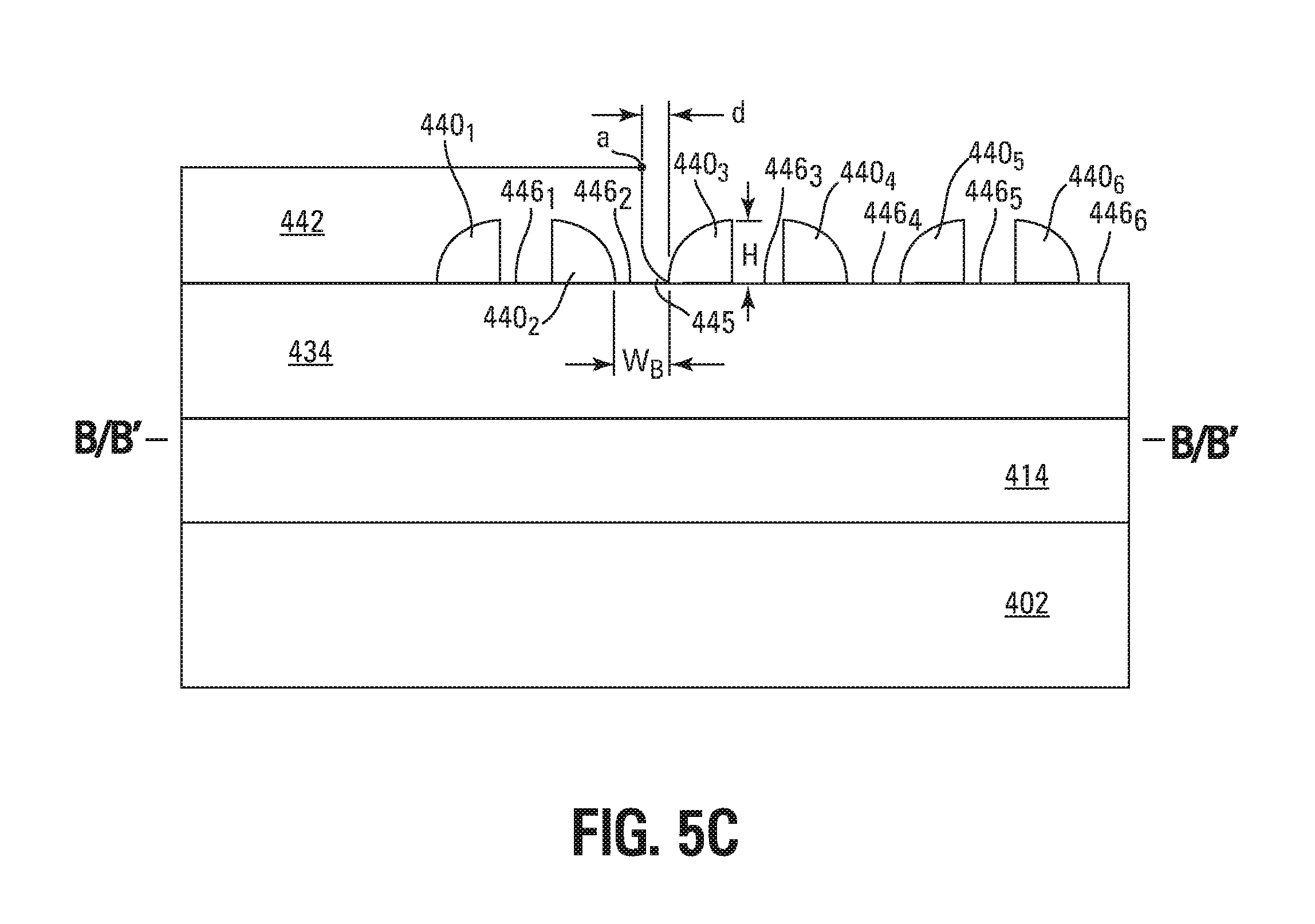
D00013

D00014
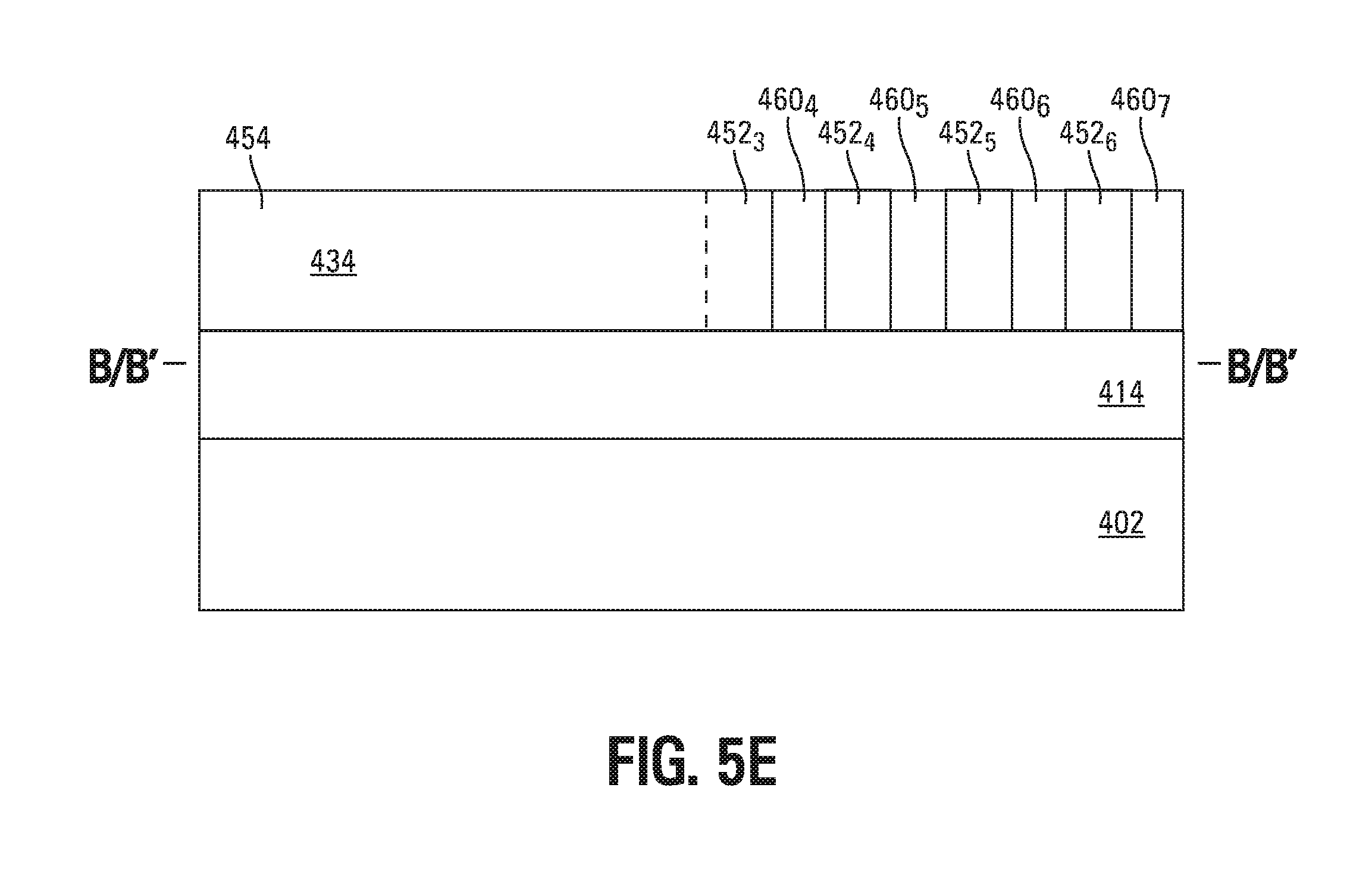
D00015

D00016
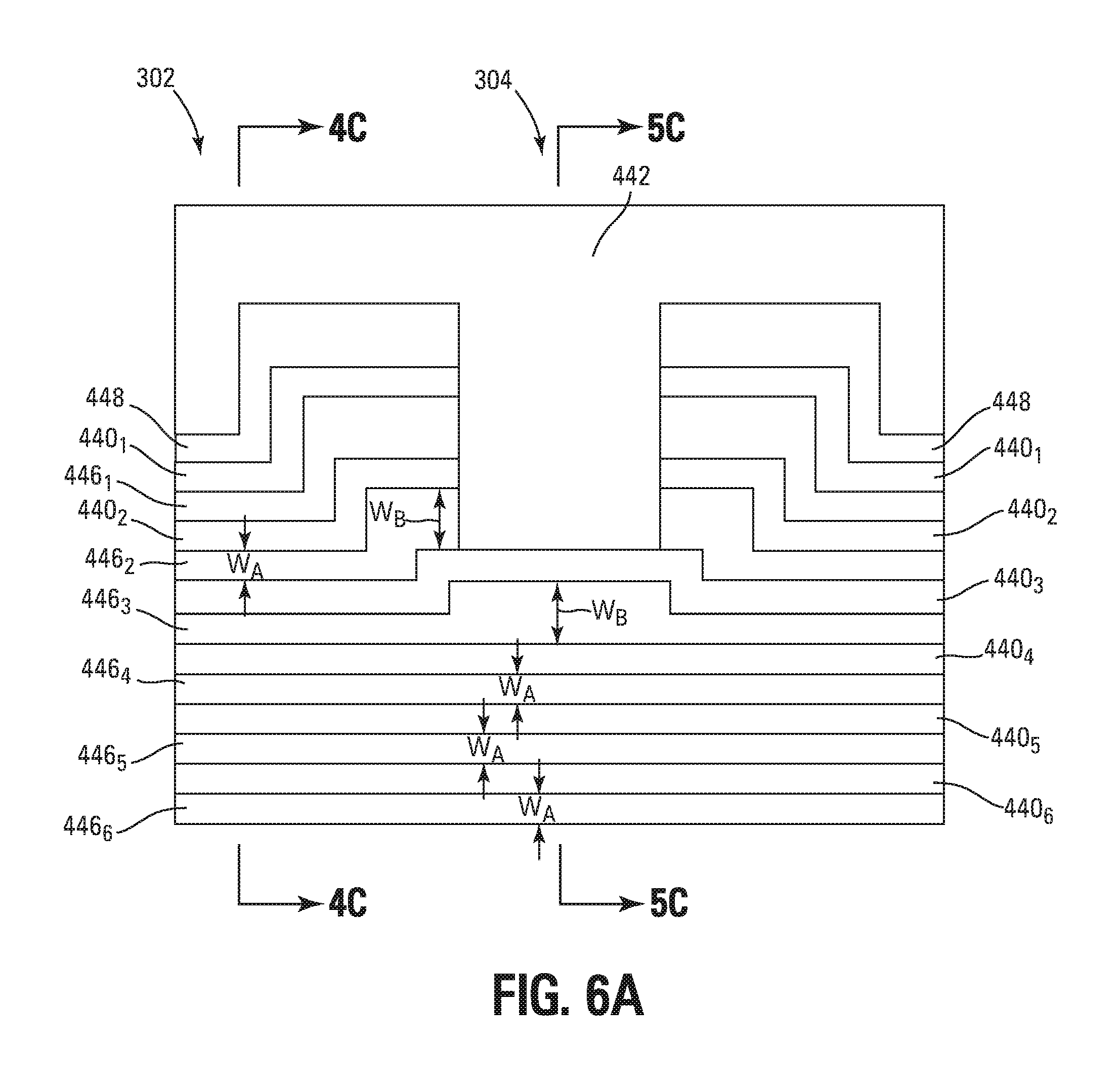
D00017

D00018
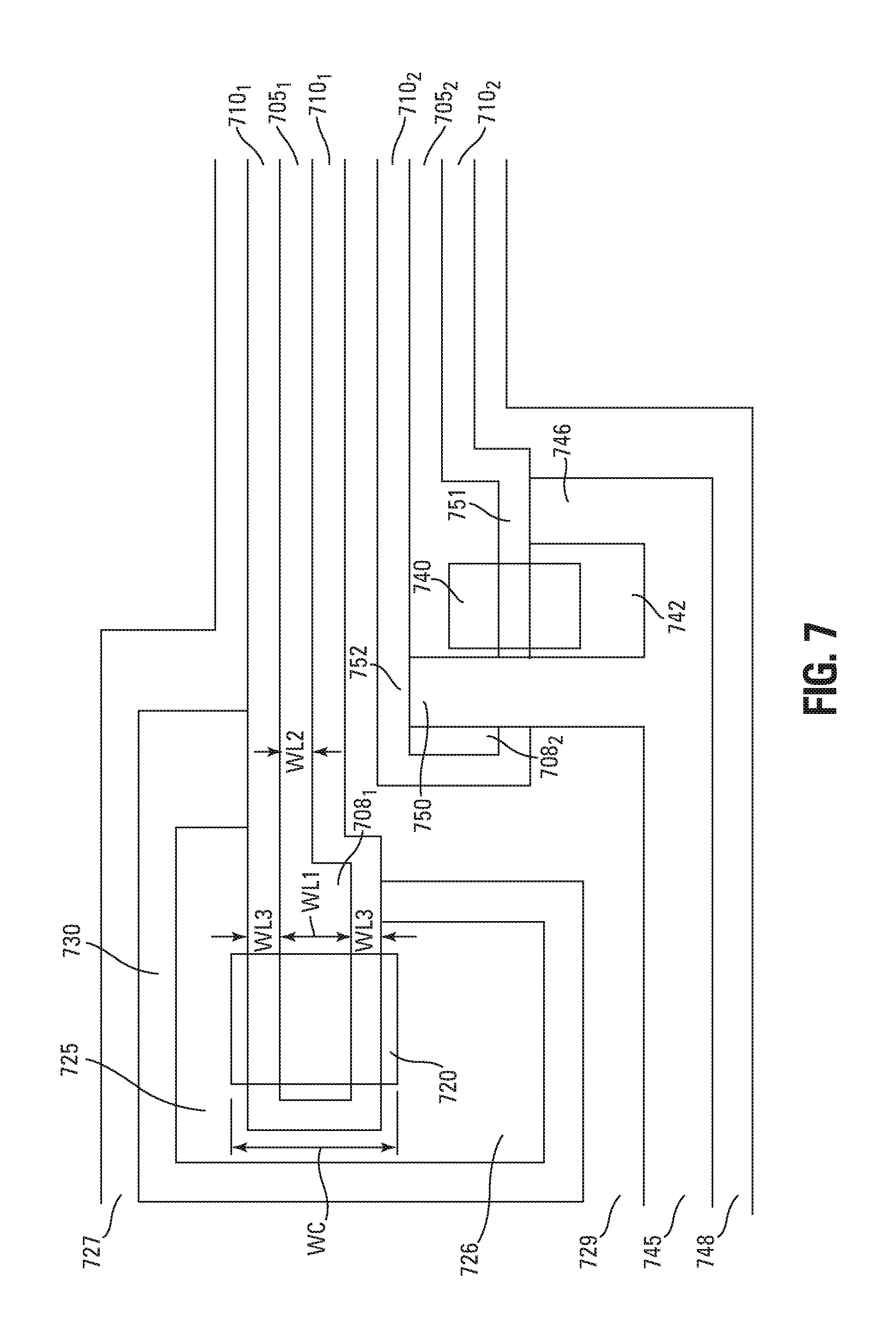
D00019

D00020

D00021
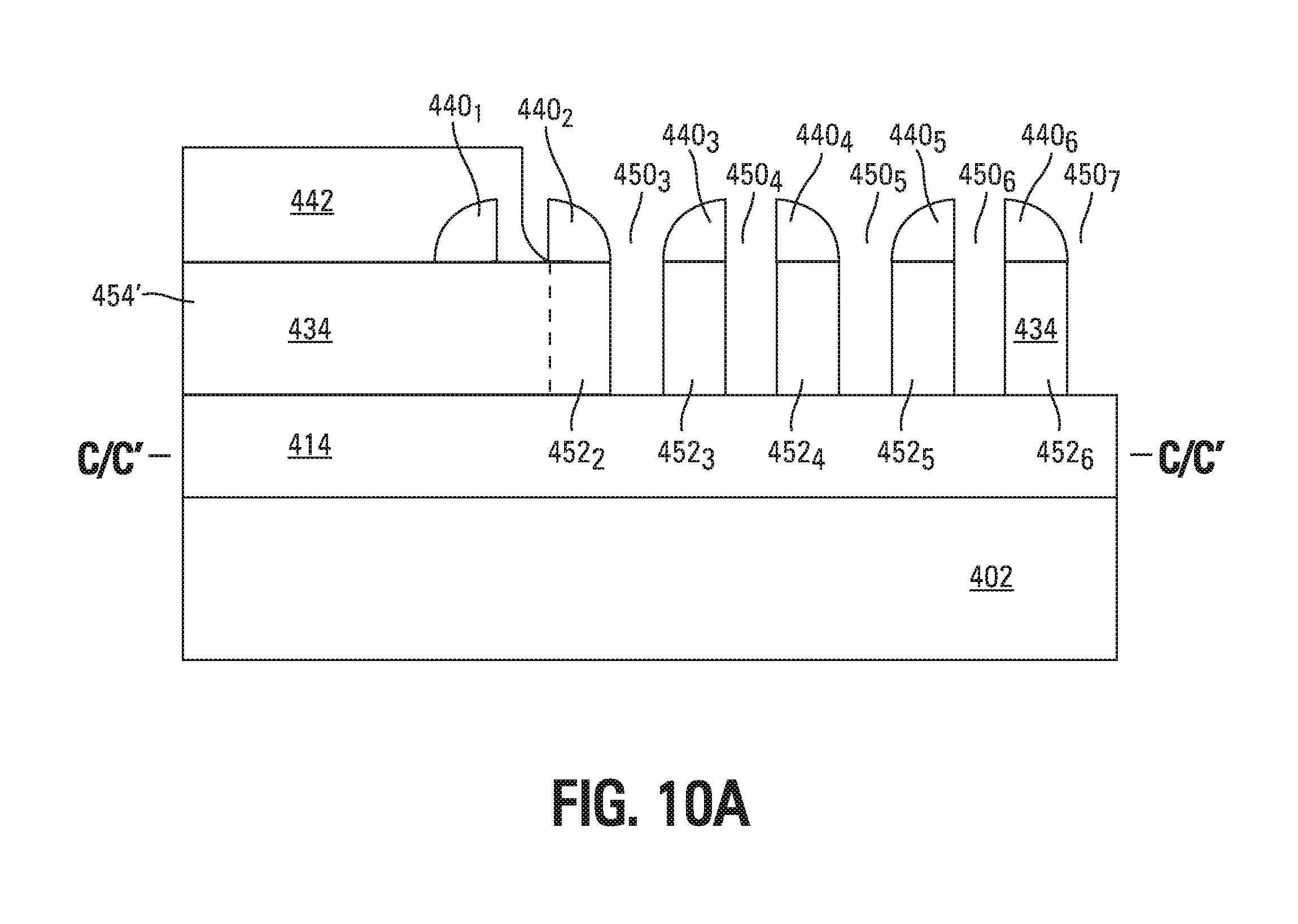
D00022
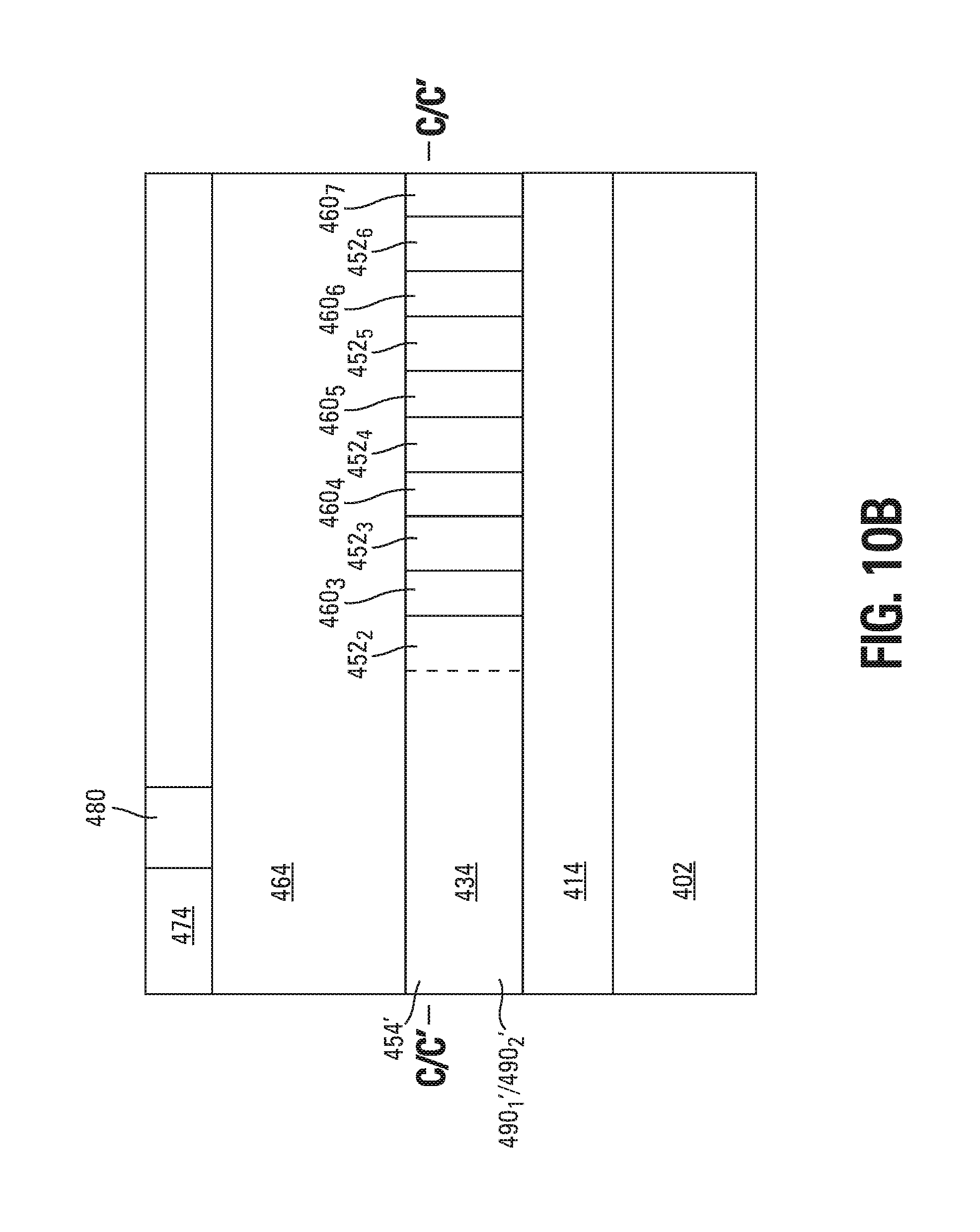
D00023

XML
uspto.report is an independent third-party trademark research tool that is not affiliated, endorsed, or sponsored by the United States Patent and Trademark Office (USPTO) or any other governmental organization. The information provided by uspto.report is based on publicly available data at the time of writing and is intended for informational purposes only.
While we strive to provide accurate and up-to-date information, we do not guarantee the accuracy, completeness, reliability, or suitability of the information displayed on this site. The use of this site is at your own risk. Any reliance you place on such information is therefore strictly at your own risk.
All official trademark data, including owner information, should be verified by visiting the official USPTO website at www.uspto.gov. This site is not intended to replace professional legal advice and should not be used as a substitute for consulting with a legal professional who is knowledgeable about trademark law.